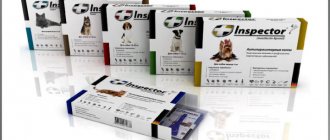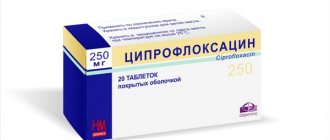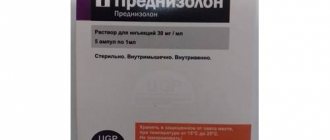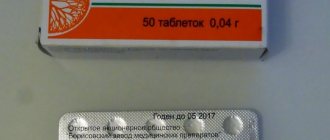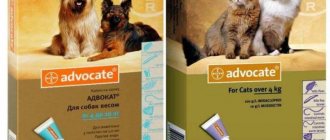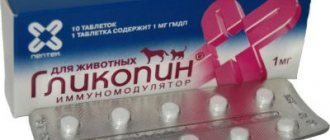Anti-parasite drug
- Fact 1:
This is a rather expensive drug; 1 package of 2.68 ml can cost 750 rubles. - Fact 2:
The liquid itself is odorless, the pipette is easy to use, and the effect after application is quite long lasting - Fact 3:
It can even treat dogs that are expecting or nursing offspring from parasites. - Fact 4:
Be careful that the aerosol should not get into your pet’s eyes or mouth.
Frontline Combo is a drug against ectoparasites for dogs weighing from 2 to 10 kg, from 20 to 40 kg, from 40 to 60 kg.
Every time you go for a walk, your tailed pet runs the risk of carrying a variety of parasites. The world around is teeming with insects and for some of them, dog hair is simply a heavenly place to settle down with maximum comfort. In addition to simple discomfort in the form of small bites and constant itching, there is also an outright danger: a tick infected with encephalitis absolutely does not care into whose blood, dog or human, it injects its deadly poison.
Of course, the threat of parasite infection is not a reason to deprive your pet of fresh air. But it is necessary to take care of the cleanliness of his coat and skin. Especially for this, there is Frontline, a means for the fastest possible destruction of various living creatures on a dog’s body and fur and effective protection against repeated invasion by uninvited guests for several months.
Description and composition
Frontline is a whole series of drugs for cats, dogs and ferrets from the international brand Merial (located in Lyon, branded by Boehringer Ingelheim). The company also produces vaccines and anti-worm medications, cosmetics and much more.
Repellents for Frontline are available in several forms:
- Spot-on (disposable pipettes);
- Pills;
- Spray;
- Combined drugs against several types of parasites.
The active ingredients in the products are different. These can be fipronil and S-methoprene, afoxolaner, permethrin. All of them are safe and do not cause allergies in animals.
Overview of the features of the Frontline action
Frontline refers to products used to eliminate and prevent the appearance of ectoparasites in cats and dogs. The drug has a superficial effect. After use, the components of the drug do not enter the blood, but are distributed over the surface and accumulate in the sebaceous glands. From these, the drug is gradually applied to the skin in the amount necessary to destroy parasites. Thus, after a single treatment, the effect of the drug remains for a fairly long period.
Fleas on a cat
Frontline destroys the following types of skin parasites:
- fleas;
- ixodid ticks;
- cheilitels;
- otodexodes;
- lice eaters;
- lice.
Life cycle of a dog flea
Frontline is produced in several forms, allowing you to choose the one that will be convenient to use for the animal owner.
Frontline composition
The main substance that provides the insecticidal effect of the drug is fipronil. In addition, in various forms of release, Frontline can be supplemented with several substances to enhance effectiveness. Among them:
- butylated hydroxyanisole;
- ethanol;
- butylated hydroxytoluene;
- excipient.
Chemical formula of finpronil
Pharmacology
Fipronil, which is the basis of the drug, affects insect receptors, disrupting the movement of impulses. This causes paralysis and subsequent death of the arthropods.
Frontline is active against almost all common skin parasites of animals. Accumulating in the hair follicles, epidermis and sebaceous glands, fipronil enters the animal’s skin along with the secretion. The effect occurs after 24-48 hours. During this time, the parasites present on the animal die, and the drug is completely absorbed into the skin. The protective properties last for a period of 15 to 45 days. The duration of exposure largely depends on the size of the animal, characteristics of care and accommodation.
The structure of a dog's skin
Contraindications and side effects
After the studies, no obvious side effects or contraindications to the use of the drug were identified. The manufacturer recommends refraining from treating kittens weighing up to 1 kg with the universal product to avoid overdose. If there is a need to process them, it is better to use Frontline, created for small animals. The concentration of the active substance in such preparations is significantly lower than in products for adults. They have a gentle effect on the still fragile body.
Treatment of a kitten with Frontline, created for small animals
It is also recommended to avoid using the product on animals with damaged skin. Multiple wounds can lead to penetration of the active substance into the blood. This will not cause any negative effects on your pet, but may cause minor short-term deterioration in well-being.
How do drugs work?
Attention! Before use, consult a specialist.
You need to choose a product based on your pet’s problems and taking into account what parasites live in your region.
Frontline Act Three
It acts on 18 species of flying insects, and not only repels them, but also has an insecticidal effect. Thus, the product prevents many diseases, including piroplasmosis, Lyme disease, leishmaniasis, etc.
Frontline NexgarD tablets
Used to combat ticks and fleas. It works faster than drops and is suitable for both adult dogs and puppies. The effect of the tablet lasts about a month.
Frontline spot-on
Suitable for those animals that cannot walk in a collar or do not recognize the spray. Can be used every month. Fights otodectosis in animals.
Frontline combo
Can be used not only for dogs, but also for cats and ferrets. It destroys ticks in two days, fleas in a day. It is water resistant.
Frontline spray
It works quickly (as soon as it dries on the fur), but is not very suitable for large animals. Does not cause local allergic reactions.
Alternative to topical products
Veterinary clinics and pharmacies also offer another form of Frontline - Nexgard chewable tablets, in packs of 3 tablets of 136 mg. Each pill contains afoxolaner, a substance that begins its action when it enters the animal's circulatory system. 30 minutes after the dog eats the tablet, the active components already affect the parasites.
There is no need to worry that if the product enters the gastrointestinal tract it will cause any harm to your pet. Nexgard is absolutely safe for caudate patients. In addition, any pet will like it because of its taste. The plates have the smell and taste of beef stew, so beloved by dogs, which means there will be no problems with swallowing the product. And the drug is convenient: for effective results you only need to feed it to the animal once.
Mechanism of action of drugs
The drugs contain different substances, their mechanism of action is different. But the main thing is that in complex preparations the active substances do not neutralize each other’s work.
- Fipronil, entering the insect's body through the skin, blocks the transmission of nerve impulses, and this disrupts the functioning of the nervous system and leads to paralysis. Insects die in about 8 hours.
- S-methoprene does not allow chitin to develop correctly, therefore it stops the development of fleas that are in the egg, pupa or larvae stage. Penetrates the shell of eggs that have been recently laid.
- Afloxaner is a GABA-dependent receptor blocker, disrupts the transmission of nerve impulses and provokes the development of paralysis in insects.
- Permethrin inhibits the polarization of nerve cells in insects, which also leads to paralysis.
Is it worth paying more?
With all the hype and popularity of the drug, one should not forget what made it so powerful. Yes, yes, it's all about the active substance. In the drug "Frontline" it is fipronil, obtained quite recently. The essence of its action is that it affects the GABA channels of insects, interfering with the passage of chlorine ions. As a result, the pest's nervous system collapses and it dies. At the same time, it does not harm the mammal. According to official data and reviews, Frontline can cost from four hundred to one and a half thousand rubles, depending on the characteristics. But the prices for other drugs with the active ingredient fipronil are much more affordable: from one hundred rubles.
Release form
Not only the active ingredients, but also the release forms differ among Frontline products.
NexGard
Anti-tick and flea medicine in the form of tablets with veal flavor. The active substance is afloxaner. Suitable for pets aged from two months and weighing from two kg. Effective against mature insects, larvae and eggs. The action begins half an hour after administration. Ticks die in two days, fleas in 6 hours. It is very important to follow the dosage:
- A dog weighing up to 4 kg needs 11.3 mg of active ingredient. This is 0.5 g of the drug;
- Animals weighing up to 10 kg need 23.3 mg of afloxaner. This is a tablet weighing 1.25 g;
- Pets weighing up to 25 kg need 68 mg of active ingredient. The weight of the tablets is 3 g;
- With a weight of up to 50 kg, give 6 g of the product. This is 136 mg of afloxaner.
The product is effective for flea allergic dermatitis. Give once a month. If the dog does not eat the tablet, crush it and give it with food.
Nexgard tablets can be purchased in the Beethoven online store, they cost from 1200 to 2000 rubles.
Spot-on
A classic remedy for ticks and fleas in the form of drops. More effective against many types of ixodid ticks at different stages of development, fleas and lice-eaters. Toxic to fish, other aquarium animals and rabbits. Destroys insects within a day, lasts about 4 weeks.
After using the product, you should not bathe your pet for about two days. Available in pipettes of different volumes, and 1 ml of the drug is 1 mg of fipronil. One pipette – one dose for a dog. Available in several different dosages:
- 0.67 ml for dogs weighing up to 10 kg;
- 1.34 ml for animals weighing up to 20 kg;
- 2.68 for a dog weighing up to 40 kg;
- 4.02 for a pet weighing up to 60 kg.
The minimum price for Spot-On drops is 550 rubles.
Frontline spray
Medicine for the smallest pets. Can be used for animals that are 2 days old. The active ingredient is fipronil. The composition contains purified water, isopropanol, copovidone. The dosage is calculated based on the length of the coat. For 1 kg of dog or cat weight you need from 3 to 6 ml of spray. If the volume of the bottle is 100 ml, when pressed, 0.5 ml of spray is sprayed, if the volume is 200 ml, 1 ml of spray is sprayed.
A 250 ml spray costs from 1,500 rubles.
Combo
Combination of fipronil and S-methoprene. Effectively destroys ixodid ticks, fleas and lice. Kills ticks in 24 hours and fleas in 48 hours. Valid for up to 12 weeks (for fleas up to 4 weeks). Dogs need to be treated once a month. It is applied to the withers, after which the drops spread throughout the dog’s entire body. Available in pipettes of several volumes. One pipette – one dose of medicine:
- S – for dogs weighing up to 10 kg (0.67 ml);
- M- for animals weighing up to 20 kg (1.34 ml);
- L – for dogs weighing up to 40 kg (2.68 ml);
- XL – for dogs from 40 kg (4.02 ml).
Combo drops cost at least 498 rubles.
Three Act
Effective for all insects that fly. One pipette (0.5 ml) contains 33.8 mg of fipronil and 252.4 mg of permethrin. The dosage is slightly different from other drops:
- Dwarf breeds weighing up to 5 kg need 0.5 ml of the product;
- Weighing up to 10 kg – 1 ml of product;
- Up to 20 kg – 2 ml;
- Up to 40 kg – 4 ml of product;
- Up to 60 – 6 ml of product.
Needs to be processed every month.
For puppies and small breeds, Frontline spray is effective, but drops can be used in a minimal dosage. Tri-act is used for puppies from 8 weeks. The spray is used from two days of age. Nexgard and Spot-on are acceptable from two months of age and for animals weighing over 2 kg.
Instructions for use
Each form of the drug Frontline is supplied with detailed instructions. But the pharmacy will not always let you familiarize yourself with it before purchasing, so you can study all the intricacies of this product in advance. In addition, the seller at the pharmacy may give inaccurate information (for example, in order to sell another drug).
The pharmacist told me that drops on the withers and Frontline spray provide only 50% protection against ticks. Previously, yes, they were very effective, but now ticks have already adapted to them.
Viktorella, forum visitor
https://www.mydog.su/forum/frontlain-uzhe-ne-spasaet-ot-kleshchei
Classic drops Spot On
Before using drops, read the instructions for use
Before using Spot He drops, you need to calculate the dosage. According to the instructions, one 0.5 ml pipette is enough to treat a cat. For convenience, you can use the following diagram:
- Break off the tip of the pipette.
- Use your hands to spread the fur in the withers area (above the shoulder blades).
- Press the pipette and squeeze the entire solution into one place.
The liquid will distribute itself over the animal’s skin (this will take approximately 24 hours). If we are talking about the treatment of ear scabies, then the solution should be dripped directly into the pet’s ears (4-6 drops in each ear). To ensure that the solution is evenly distributed, the auricle can be carefully folded in half and lightly massaged. The remaining solution can be applied to the withers. The next time you use it (in about a month), you will need to use a new pipette.
If you plan to constantly (monthly) use drops for prevention, then it is more advisable to buy packages of 3 pipettes (it’s cheaper).
Video: how to apply Spot on drops
Drops Combo
According to the instructions, Combo drops should be applied to one or several points. Important: the protective effect of Combo against ticks lasts for 3 weeks. If you need to prevent infection by ticks, then the frequency of treatment can be reduced to once every 3 weeks (consult your veterinarian). However, it is recommended to carry out treatment no more than once a month. This period is reduced to 3 weeks if the cat is bathed frequently (for example, 2 times a month). Although it is not recommended to bathe the cat immediately after application (48 hours). It is also not recommended to use other insectoacaricidal agents together with Combo.
The manufacturer assures that if all recommendations are followed, the drug will not have any negative effect on the body. But cat owners sometimes experience a slight deterioration in their cat’s well-being. It is not recommended to treat weakened cats (for example, after illness).
If the drops get into the animal's eyes, there may be slight irritation, which will go away without any intervention. An allergy to the drug can occur if the animal has an individual intolerance to the components of the drug. In both cases, if unpleasant symptoms appear, the treatment should be stopped and the solution should be washed off the cat with running warm water. You can give your pet antihistamines. You can call the clinic and find out which allergy medicine is right for your pet. Usually they give Suprastin or Tavegil.
When working with Frontline, you must follow the safety and personal hygiene rules:
- while working with drops, do not drink, smoke, or eat;
- You can use rubber gloves to protect your hands, and a medical mask or respirator to protect your face;
- If the product gets on your skin, it should be washed off with running water;
- if drops get into your eyes or mouth, you should immediately rinse them and then consult a doctor;
- After finishing work, hands should be washed with soap and the used pipette should be disposed of.
Video: applying Frontline Combo drops
Spray Frontline
Using a spray may seem unusual because the process will be different from using drops. According to the instructions, you need to follow several rules:
- Spray the product at a distance of 10–20 cm (for better distribution).
- You need to spray the solution in the direction of hair growth so that all the hair gets wet (right up to the skin).
- Long-haired cats can be combed when spraying so that there are no dry areas left.
- To treat the face, apply the spray to your hand and then gently rub the liquid into the cat’s fur.
- Rub the solution into the fur on the face until it dries completely.
- Do not apply the solution with your hands or spray it into your cat's eyes.
- Do not use towels when spraying a cat.
Spray dosage: 6–12 presses of the spray button per 1 kg of cat’s weight. That is, to treat a cat weighing 3 kg you need to make at least 18 “sprays”. The spray will be active:
- against ticks - up to 5 weeks;
- against fleas - up to 3 months;
- against lice eaters - up to 42 days.
However, despite such different periods of time, it is recommended to carry out repeated treatment no earlier than 4 weeks after the previous one.
The spray must be applied with extreme care; it should not come into contact with the eyes or mucous membranes.
The spray can cause eye irritation not only in the cat, but also in the person who sprays it, so following safety rules in this case is especially important - use a mask, goggles and gloves. This spray should not be used by cats or people with hypersensitivity to the components of the drug. The fact is that the excipient in the spray is alcohol. There are also other restrictions mentioned by the manufacturer:
- Do not allow product to come into contact with exposed skin.
- If the spray gets on your skin, eyes or mouth, the solution should be washed off immediately.
- Even if you worked with gloves, wash your hands thoroughly with soap after handling the product.
- Children should not be allowed to play with a treated cat.
- Do not touch the cat until it is completely dry.
- It is not recommended to drink, eat or smoke while working with the spray.
- Kittens under 2 days old cannot be treated with the spray.
It is best to treat your cat in the evening (shortly before bed).
In our family, all relatives on my father’s side (including me) suffer from the most ridiculous allergy - a reaction to alcohol-containing liquids. If I have a sore throat, then I can’t use any “sprays” in my throat, only lozenges and gargles. We also shouldn’t make compresses or get carried away with perfume. All my fragrances are oil perfumes brought from the Emirates and Turkey. Of course, sprays for animals are also contraindicated for me. We cannot help but take this into account, because when working with such a product, we not only smell the alcohol, but also inhale its small drops.
Avoid using Frontline spray if you are allergic to alcohol
By the way, the instructions say that this spray is generally prohibited from being used by weakened animals, but then, a year ago, we did not read this, completely trusting the consultant. And in general, everything went without complications, the fleas died, and the cat-cat recovered.
OlinaLina, forum user
https://irecommend.ru/content/sprei-frontlain-ot-blokh-vshei-kleshchei-i-dazhe-komarov-opyt-primeneniya-na-kotenke-i-vzros
If your cat licks itself immediately after applying the solution, it may begin to salivate more, but this is only due to the chemical composition of the spray. Sometimes after using Frontline spray there may be unpleasant reactions:
- skin redness;
- itching at the application site;
- formation of bald spots;
- depression or increased nervousness (very rare);
- difficulty breathing or shortness of breath;
- nausea, vomiting.
The cat owner should remember that using a spray cannot guarantee a 100% result. In some cases, several parasites may survive, leading to their recolonization on the animal's body.
Video: how to apply Frontline spray
Can it be used in pregnant cats and kittens?
Frontline can be used to protect and treat pregnant, lactating cats and kittens (at least 2 days old). If we are talking about a nursing cat with kittens, then there is a small nuance - immediately after applying the drug, the kittens must be isolated from their mother (at least until the solution dries). There is no need to treat the nipples; the area around them should be moistened carefully (if we are talking about a spray). By the way, in such cases it is most convenient to use drops (the kittens will definitely not reach their mother’s withers). And if parasites (for example, fleas) appear in very young kittens, then a spray will do. Usually the entire procedure proceeds without consequences. The developers assure that if the recommendations are followed, the kittens and their mother will not have any side effects.
There is no need to go to the vet. Firstly, the action of the frontline is quite long, frequent treatments are generally useless, and secondly, the mother is still weakened after childbirth, she does not need unnecessary stress. In addition, there is a high risk of contracting an infection in the clinic, and this is very dangerous for kittens.
Which, forum user
https://forum.kotodom.ru/topic10390.html
Pregnant cats are treated in the same way as others - according to general rules.
Frontline can be used to protect and treat even small kittens
Interaction with other drugs
The developer warns that Frontline should not be used simultaneously with other insectoacaricidal drugs. But sometimes there are situations when one flea and tick medication does not work properly. A few days later, the cat’s owners try to use another remedy, and after that they turn to the veterinarian with the question “whether the cat will be poisoned.” Most protective drugs are designed so that the correct dosage cannot cause poisoning, so veterinarians allow the urgent replacement of one drug with another.
Frontline is not recommended for weakened animals, so its interaction with antibiotics and other strong drugs is excluded. If you think that your cat should be treated with Frontline, but at the same time she is being treated with some medications, then you can always contact a veterinarian. After all, there are exceptions to any rule.
My neighbors’ cat picked up ticks (the owners’ two-week vacation spent at the dacha had an effect). On the advice of friends, neighbors bought Frontline, which can be instilled into the ears. The head of the family suspected that the first application did not bring the desired result, so at the family council it was decided to repeat the instillation. After the second time, brown dirt appeared in the cat’s ears. The cat's owner's first thought was that the drops were fake. Of course, after such an event, the couple decided to take the poor thing to the vet. It turned out that the tick died after the first instillation, and the dirt in the ears was the result of otitis media. The veterinarian prescribed ear drops and vitamins, and they had to be taken on the same day, although not even a day had passed since the last use of Frontline.
Sometimes Frontline is combined with symptomatic drugs
Processing technique
When applying drops, it is recommended to wear rubber gloves. You cannot bathe your pet for two days before treatment and for the same amount of time after it. Drops should not be used if the animal has an infectious disease and is weakened. The next day after treatment, you should not pet the animal or allow it near children. You should not eat, smoke or drink during surgery. Healthy pets also need to be treated.
The drugs are not used if there are injuries on the skin or if the fur or skin is damp. Apply to dry and clean skin. We do not combine drops with other insectoacaricidal agents. Do not use drops if you yourself suffer from allergies, respiratory or dermatological diseases. We apply it like this:
- Before applying, remove the dog's collar, accessories, and clothing;
- We spread the fur at the withers (where the dog cannot lick it);
- We drip onto the skin. We don't rub it in. Do not touch until the wool is dry.
When applying the spray, you also need to follow the rules. We put a muzzle on the pet, a neck collar, and fix the jaws. Do not remove until the wool is dry. Apply to dry skin and coat. We put on gloves.
We spray anti-hair spray all over the dog's body. If the hair is long, lift it. We cover the dog's eyes when treating the ears and chest. Lightly rub the spray into the areas around the eyes and nose with your fingertips. If the spray causes vomiting, muscle tremors and salivation in the animal, rinse with plenty of water. We also treat the bedding with a spray. We do not allow the dog near the fire for an hour after the procedure.
General rules when using the drug
- Protect your hands with gloves when handling and protect your mucous membranes.
- After the procedure, wash your hands with detergent.
- Do not pet your pet for 2 days after applying the drug.
- Do not wash for 48 hours after treatment.
- Keep children away from the dog for 2-3 days.
- Do not use the anti-parasite collar at the same time as Frontline.
With the onset of the warm season, your pet needs to be treated monthly. In winter, you can limit yourself to once a quarter.
Contraindications, side effects
All products from the Frontline line, except for the spray, are approved for use during pregnancy and nursing puppies. The spray is not recommended for productive animals. The drugs are contraindicated in case of hypersensitivity to fipronil, afloxaner, S-methoprene and permethrin. Tablets are contraindicated in case of problems with the kidneys, liver, or stomach. Tablets with drops are not used for animals weighing less than 2 kg and less than 8 weeks old.
Sometimes an allergic reaction develops to drugs. You need to fight it with antihistamines. Allergies make themselves felt in the form of vomiting, muscle weakness, drooling, and trembling limbs.
The drugs are not prescribed to dogs that are weakened after illness, suffer from infectious diseases, after surgery, or with skin damage.
Directions for use and dosage
Sprays and drops on the withers are applied only externally, to the skin. The skin of the animal being processed must meet the following requirements:
It should be dry.
It is highly desirable that the skin be clean. The purer it is, the more evenly the medicine will be distributed throughout it, and the more pronounced its effect will be. Veterinarians advise washing your pet before treatment. The use of shampoos with an antiparasitic effect is not prohibited, but before doing so, you should consult a veterinarian (to avoid drug incompatibility).
It cannot have cuts, scratches, areas of inflammation or other types of erosion. Otherwise, the risk of poisoning increases sharply (the pure drug should not end up in the general circulation).
If there is a rash or signs of dermatitis on the skin, or there are other symptoms of allergic pathologies, the use of the drug should also be postponed “until better times.”
The spray is somewhat easier to use: it is used to evenly irrigate the pet’s fur on all parts of its body. True, after this the cat will need to be occupied with something for about an hour so that she does not have time for licking.
In the case when chewable tablets are used, the cat should not have pathologies of the digestive system, that is, constipation or diarrhea. In addition, it is highly undesirable to treat animals (regardless of the dosage form used) suffering from acute or chronic liver and kidney diseases.
Application of drops/spray
In such cases, the medicine is applied to the withers, between the shoulder blades. The fur needs to be parted (we remind you that it must be clean), after which the required volume of the drug is applied to the exposed skin.
When treating ear mites, everything is somewhat more complicated:
It is necessary to clean the ear canals from deposits of mite waste products. To do this, you can use either 3% hydrogen peroxide or sterile vegetable oil (you can make it yourself by “calcining” the oil in a water bath). Regular cotton swabs are ideal for this purpose. You need to clean your ears carefully, being careful not to damage the ear canal or eardrum.
After this, you need to drop a couple of drops of medicine into each ear canal. Plug the ear canal for about a minute with a finger, while lightly massaging the skin at the base of the ear. These actions help the medicine to be distributed more evenly, which significantly increases the effectiveness of treatment.
For treating cats, we recommend using only 0.5 ml pipettes. In this case, the dosage is extremely simple: one dispenser per animal.
Use of chewable tablets
With them everything is much simpler: the drug is given once, orally, always with food.
But! Considering the variety of packaging, release forms and concentrations of the active substance, we can give only one piece of advice: carefully read the instructions for use included with the medicine by the manufacturer! With tablets, everything is much simpler: the medicine is given at the rate of 2.5 mg of active substance per kilogram of live weight.
Breeders reviews
Reviews of Frontline products are positive and not so positive. Here are some opinions from breeders.
Antonina, owner of two bulldogs:
“My favorite drug from Frontline is Tri-Act drops. They are cheaper than other effective drugs. The drops do not enter the bloodstream and are harmless to the dog. For the fight against ticks, this is the most effective remedy: it contains components that do not give life to ticks. They saved us not only from ticks. Once I myself brought fleas home while feeding the cat in the basement. The insects immediately settled on the dogs. I had to quickly treat them with drops. Nobody was itching. But it is important to treat dogs regularly: if you wash them with shampoo, then more than once a month. I drip once every 21 days.”
Gennady, retriever breeder:
“I don’t give fleas and ticks any chance, I carry out regular prevention. My favorite product is the classic Frontline Spot-on. The drops are safe, do not circulate in the blood, and are difficult for them to enter the dog’s mouth. And they act immediately. But I process dogs starting in April and finish in November. The advantage of Spot-on drops is that they act against several types of parasites. I don’t kill two birds with one stone, but ticks, fleas, and lice eaters. I don’t plan to change the drug yet.”
Angelina:
“When I had one poodle, I used a flea collar. But now I have two of them, and I also have a little son. The collar is not suitable, it causes allergies in the child. I also read that if there are several dogs, they bite each other’s necks with collars. And this is poisoning.
Now I have switched to drops. My favorite is Frontline Combo. They are effective, but there are a few caveats. It’s good if more than three days have passed since swimming. The drops spread quickly over oily skin. There is a second point. The drug paralyzes insects, but they die slowly. If you see a barely alive flea on an animal’s body, this does not mean that the drops did not work. Pests may die slowly. Be sure to check your pets after every walk.”
Alena, owner of the Yorkie:
“I used drops and spray from Frontline. The products are good, but not cheap. If I find ones that are just as effective, but cheaper, I’ll switch to them. For now, only Frontline.”
Advantages and disadvantages of products
The history of the use of the pharmaceutical drug in veterinary practice allows us to place Frontline for cats on a par with other known products against fleas and ticks. The ratio of pros and cons determines the feasibility of its use. The advantages of the drug are:
- Highly effective against several types of ectoparasites.
- Wide range of effects (acts on different stages of development).
- Prolonged period of activity of fipronil.
- Harmlessness of active ingredients for the pet itself.
- Can be used for kittens and pregnant cats.
- Convenient application of the product to the fur or skin of an animal.
Frontline Spot On, Combo and Spray have their drawbacks. So, the liquid product must be dosed strictly, based on the cat’s weight. If the amount of the drug is insufficient, the effect is not achieved. Exceeding the optimal dose may have a negative effect on your pet's health.
When spraying Frontline spray, it may come into contact with the cat's mucous membranes. This causes local irritation and redness. If such a nuisance occurs, the cat should immediately rinse its eyes and nose with running water. The pet cannot be petted or bathed for two days. The use of a toxic liquid requires strict adherence to hygiene rules (washing hands after handling).
Frontline has a characteristic unpleasant odor that not all cats like
Reviews from veterinarians
Valentina B. (St. Petersburg):
“When dealing with insects in dogs, prevention is important. Examine your dogs after a walk, carefully look for ticks, fleas, lice eaters, and other insects. Frontline preparations provide protection against parasites and prevent diseases carried by ticks, lice eaters, fleas, and mosquitoes. Use medications strictly according to instructions. I consider drops and sprays less dangerous than tablets. They will not get into the oral cavity and will not cause poisoning. But the spray must be used with caution. There is no need to be afraid of these funds. The risk of poisoning is low, drops, spray, tablets are harmless"
Indications and contraindications
Indications for the use of Frontline drops are the presence of one of the following factors:
- The need to destroy fleas , lice, any type of ticks or lice in the event of visual detection of the presence of these parasites.
- Prescription of the drug by a veterinarian.
- Preventive measures necessary after contact with sick animals, when traveling into nature or visiting potentially dangerous places where infection with parasitic species of insects can occur.
However, there is a list of contraindications; before using Frontline, you need to make sure they are completely absent:
- The presence of any infectious, viral or other diseases , as well as chronic diseases during their exacerbation.
- Rehabilitation period after illness or surgery.
- The presence of open wounds or other damage in areas that must be treated.
- A general weakened state of the dog's health or immune system.
- Weight less than 2 kg.
- Less than 8 weeks old.
Analogs
Fipronil is a popular remedy for ixodid ticks. There are many analogues containing it:
- Palladium Ultra Protect (drops);
- Bravecto;
- KRKA Fiprist;
- Sentry FiproGuard Max (contains cyphenothrin);
- Dana-Ultra from Api-San;
- Vet Agro Fiprex spray;
- Centrovet Rexolin;
- Bars-Forte;
- Barrier-Super.
Permethrin is also popular for insect control. Here are analogues with its content:
- Canigard SpotOn;
- Vectra 3D;
- Neostomasin;
- Drontal plus;
- Prazicide;
- Sentry.
S-methoprene is contained in Fipren, Certifect, Rexolin, Profi Line drops, Palladium Pet Line.
Frontline spray
The aerosol product is produced in bottles of 100; 250 ml.
The cost of a 100 ml bottle in September 2021 is 845 rubles.
The spray protects cats from ixodid ticks for 3 weeks, fleas - 6 weeks. The dogs will be free of ectoparasites for 5 and 12 weeks respectively. Dispense the drug with the number of presses on the spray head in accordance with the table:
| Live weight, kg | Number of clicks | |
| 100 ml | 250 ml | |
| 5 | 30 | 10 |
| 10 | 60 | 20 |
| 15 | 90 | 30 |
| 25 | 150 | 50 |
The table provides recommendations for treating pets with short hair. For long-haired dogs, the number of presses is doubled. To prevent a cat or dog from licking the insecticide, place a neck collar, muzzle, or tie the closed jaws with a rope while it dries. Avoid contact of the aerosol with the eyes. Problem areas are treated with your finger after wearing gloves.
The animal should not be allowed to get wet for two days after treatment. There are no restrictions on the weight and age of the animal. The aerosol is stored for 2 years at temperatures from 0 to 25 °C.
FAQ
The instructions answer most questions about the drug, but they still arise. There are important points.
At what age can Frontline be used for puppies?
Tablets and drops are recommended from two months, spray - from two days.
How long does Frontline last on a dog?
The effect of drops, tablets, sprays is one month. If you often bathe your pet, external preparations “work” for three weeks.
Are dogs allergic to the drug?
Yes, it happens (rarely). If symptoms occur, rinse the coat. Contact your veterinarian and have him prescribe antihistamines.
Indications for use Frontline
The action of the drug Frontline in various forms of release is aimed not only at the complete destruction of ectoparasites, but also at preventing the reproduction and further development of parasites in the house.
The advantages of Frontline are:
- elimination of ticks, fleas and lice eaters on the animal’s body within 24 hours;
- protection for 30 days after one-time treatment;
- safety for all types of cats, regardless of coat thickness and age.
Indications for the use of Frontaline are:
- elimination of temporary ectoparasites – fleas;
- protection against ticks and lice;
- elimination of lice and ear scabies pathogens.
Briefly about the main thing
- Frontline series products are safe and of high quality. Each of them has its own characteristics.
- The spray is used from two days of life. Not suitable for large dogs. Effective for dwarf breeds.
- Tablets are not recommended for diseases of the liver, stomach, or kidneys.
- Drops are the safest drug.
- To make sure Frontline medications work effectively, follow the instructions.
Have we answered your question fully enough? If not, post your question in the comments below and our veterinarian will answer it.
Did you like the article? Share it with your friends on social media. networks. This will help them get useful information and support our project.
How to distinguish from a fake?
As is the case with other popular and sought-after medications, the drug is often counterfeited. There are several details that will help you distinguish a real Frontline for cats from a fake one:
- the drug is not sold in separate pipettes; even single doses are packaged in a cardboard box with an instruction leaflet;
- on each pipette there is a manufacturer's logo;
- each box is printed with the batch number, production date and expiration date, the same batch number is indicated on the plastic applicator;
- there are no holograms or stickers on the box;
- for additional protection, the pipettes are sealed in plastic packaging;
- The name, amount of solution and concentration of the active substance are indicated on the bottles and pipettes.
It can be very difficult to distinguish a fake. To avoid purchasing a low-quality product, experts advise purchasing the drug only from trusted veterinary pharmacies, and even better, at major exhibitions.
Precautionary measures
When working with insecticides, important rules should be observed:
- use rubber gloves;
- to avoid breathing toxic fumes, wear a medical mask;
- give up food, drinks and smoking;
- wash your hands with soapy water;
- Do not allow children to play with the animal during the day;
- In some cases, the drug may come into contact with the body or eyes. If this happens, immediately remove the product with warm water;
- keep medications out of the reach of children;
- used pipettes must be disposed of;
- do not throw the drug into water sources, as it is quite toxic;
- Before using the substance for kittens, consult a veterinarian;
- Expired Frontline medicine is not suitable for use.
